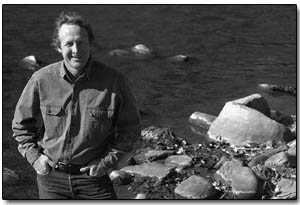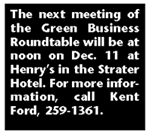Contrary to Muppet wisdom, it can be easy to be green –
at least for members of Durango’s Green Business Roundtable.
Since March, local members of the business community have gathered
for lunch once a month to network and listen to presentations
on ways to further environmental values in the workplace.
“It was sort of a sit-up-in-the-middle-of-the-night deal,
realizing that one of the things that holds back the environmental
community is our relative lack of networking,” said Kent
Ford, who conceived the idea for the roundtables. “Here
we have a town where lots of folks are concerned about environmental
issues – or are dependent on the environment – and
they weren’t networked.”
 |
| Kent Ford, seen here Monday
alongside the Animas River, came up with the idea for the
monthly Green Business Roundtables as a way for businesses
with similar interests in the environment to network while
learning green business practices.The meetings draw about
60 participants a month./Photo by Dustin Bradford. |
Ford said the roundtable is not an advocacy group. Rather,
the goal is to “inspire ourselves and other businesses
to do right by the environment.”
Ford, whose passion for the environment stems from his experiences
as a World Champion whitewater paddler, brought the idea to
the San Juan Citizens’ Alliance, which now sponsors the
lunches. Through word of mouth, around 60 people attended the
first roundtable in March, and the numbers have held strong.
Roughly 65 people attended the most recent roundtable, at which
Tom Maynard discussed transferable development rights (TDRs),
which advocates say could protect open space. Maynard is currently
developing a TDR demonstration program for Durango and La Plata
County.
Mac Thomson, a real estate agent who brought his 4-year-old
son, Al, to the meeting, said he has been to several roundtables
but was particularly interested in TDRs.
“I like business and the business model and the idea
of finding a way to take care of the earth, and this seems to
combine them,” Thomson said.
Another attendee, Tim Wheeler, of the business management and
planning firm Wheeler Consulting, said there are a number of
reasons why he attends the roundtables.
 “I
think first off (I attend) to show support for the concept of
green business, second to network, and third to learn,”
Wheeler said.
“I
think first off (I attend) to show support for the concept of
green business, second to network, and third to learn,”
Wheeler said.
Wheeler said that it is important to debunk the myth that “being
green” costs more.
“The real fundamental truth is that being green increases
profits when done properly – even done improperly sometimes,”
he said.
For example, he said that replacing traditional, incandescent
light bulbs with compact florescent light bulbs, which are more
energy efficient but cost up to $7 apiece, saves money in the
long run.
“Compact florescent light bulbs seem to cost more in
the beginning, but where else can you get a 30 percent return
on your investment? Most businesses would kill for that.”
 |
These solar panels on
top of the Smiley Building help heat the water for the building.
The system is among
the largest in the Four Corners./Photo by Dustin Bradford.
|
Charles Shaw, co-owner of the Smiley Building and past roundtable
presenter, said using compact florescent light bulbs isn’t
the only way energy is conserved at the Smiley Building. In
fact, a third of the electricity used there comes from solar
power – the roof of the building boasts one of the largest
solar panel systems in the Four Corners, he said. The building
conserves energy in other ways, including energy-efficient boilers
(and different solar panels) to help heat the building; separate
thermostats in each room; and motion sensors to activate lights
and bathroom fans.
“The solar stuff is expensive, basically because the
fossil fuels are subsidized and the solar isn’t,”
Shaw said. But he added that less expensive changes, like installing
compact florescent light bulbs, offer a quick payback - usually
anywhere from two to six months.
“I would think any business could afford that, or really,
anybody,” he said.
In fact, Ford stresses that “small steps” like
energy-efficient light bulbs, proper insulation or the use of
100 percent recycled paper are the keys to environmental sustainability.
“I think what we as a culture will have to realize in
the next 50 years is that the solutions to our problems are
going to be in lots of these small steps,” Ford said.
Of course, he doesn’t mind companies taking big steps,
too. Ford said that Mercy Medical Center is an example of a
larger local business with representatives who have attended
roundtables and taken an interest in environmental responsibility.
Brad Cochennet, chief operating officer at Mercy, said he has
enjoyed roundtables in the past, and that last month the hospital
hired a team of architects for the new hospital that includes
an engineer on the L.E.E.D. Council, a national green building
council.
“To have somebody on the national council 85 was certainly
a plus,” Cochennet said.
He added that he was impressed at the number of people the
roundtables attract.
Corey Nielsen, president of Nielsen Trading Group and Summit
Investments, a real estate investment company, said he tries
to come to all of the roundtables.
“I’ve never seen the crowd size dwindle; it’s
always strong,” Nielsen said. “Fundamentally, what’s
important is there’s a group of business people in Durango
that really care about what’s going on in this community.”
Margy Dudley, owner of the photography gallery Open Shutter,
said one green choice she’s made was opting to use bamboo
grown on a farm for the floors of her gallery in order to prevent
trees being cut down. She said she feels it is important to
conduct business responsibly.
“The way we live our lives and the way we run our businesses
– if we do it with integrity and set an example of how
to make these changes happen – hopefully it will spread
to the larger community,” Dudley said.

